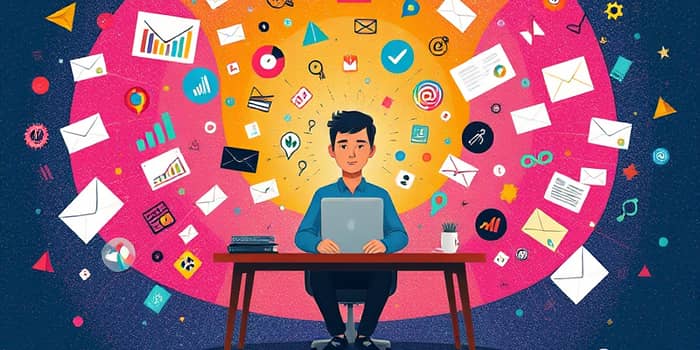
In an era where data doubles at a staggering pace and notifications never cease, it’s easy to feel crushed under a relentless tide of information. This article explores why overload happens, its impact on our lives, and how we can reclaim our focus.
Information overload occurs when the volume, speed, and fragmentation of data exceed our capacity to process it effectively. Whether through endless email threads, social media alerts, or complex reports, our brains struggle to keep pace with the ceaseless flow.
This phenomenon undermines critical thinking, decision-making, and overall well-being. By recognizing its underlying causes, we can develop strategies to focus on what truly matters.
The numbers are staggering. In 2010, the world generated 2 zettabytes of data. By 2023, this figure soared to roughly 97 zettabytes, and projections estimate it will exceed 180 zettabytes by 2025. Looking further ahead, experts predict over 2,000 zettabytes by 2035.
This explosive increase is fueled by daily activity: more than 140 billion WhatsApp messages, 2.6 million YouTube videos, and 100 million Instagram Stories are created every day. Such scale makes streamline content consumption not just helpful, but essential.
Information overload is not just a theoretical concept; it affects professionals around the globe. Recent surveys reveal:
With digital communication cited by 60% of professionals as a key burnout driver, improving how we manage data flows can transform workplace well-being.
These factors combine to overwhelm our mental bandwidth, making it hard to prioritize truly urgent or valuable input.
Being flooded with information triggers a cascade of stress responses. Some common effects include:
These consequences emphasize the need for deliberate action to restore balance and preserve mental health.
We cannot stop the data deluge, but we can design habits and environments that safeguard our attention. Consider these proven techniques:
Implementing just a few of these practices can yield immediate relief and restore a sense of control.
While digital innovation contributes to overload, it also offers solutions. Emerging AI tools can summarize lengthy articles, categorize emails, and highlight critical insights. Automation can handle routine tasks, freeing our minds for deeper work.
However, technology must be harnessed with intention. Adopting too many apps or poorly integrating tools can worsen fragmentation and friction. The key is to choose platforms that reduce unnecessary data clutter and integrate seamlessly with existing workflows.
Companies play a crucial role in mitigating overload. Leadership can:
By embedding digital minimalism at work into corporate culture, organizations foster healthier, more productive teams.
As global data continues its exponential rise—potentially reaching over 2,000 zettabytes by 2035—the stakes for effective information management grow ever higher. While we cannot reverse the tide, we can build robust strategies that ensure we remain agile, creative, and resilient.
At the individual level, adopting mindful consumption, smart organization, and periodic digital detoxes can preserve our mental clarity. Within teams and companies, fostering a culture of focus, streamlining tools, and championing good data practices can transform collective performance and well-being.
In the end, success lies in our ability to filter out noise, hone in on what truly adds value, and cultivate an environment—both digitally and mentally—that champions depth over distraction. By applying these principles, we not only survive the era of information overload but thrive within it, focusing steadfastly on what matters most.
References













